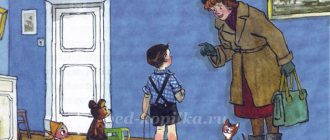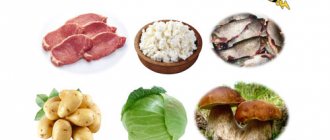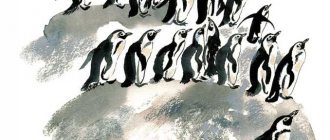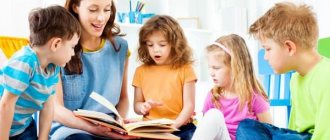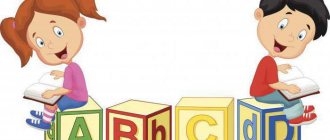GCD summary for reading fiction
Notes on reading fiction on the topic: K. Ushinsky “The Blind Horse” for children of the preparatory group
(developed in accordance with the thematic week “Pets”) Compiled by:
Teacher of the preparatory group Kataysk, 2013. GCD purpose:
Leading children to understand the moral meaning of the work.
Type of activity:
Integrative (communicative-cognitive).
Perception of fiction, productive. Form of implementation:
Frontal.
GCD tasks:
Reading fiction.
Integration (educational areas):
cognition, communication, socialization, physical education.
Objectives for educational areas: Reading fiction:
To cultivate children’s desire to listen to a work and look at its illustrations.
To develop children’s ability to consistently convey a literary text, the ability to express their attitude to the events of the story. Cognitive:
Expand children's horizons, develop listening skills.
To develop positive qualities in children: kindness, honesty, responsiveness. Communication:
Stimulate the development of initiative and independence of the child in verbal communication with adults and peers.
Develop auditory attention. Enrich and activate children's vocabulary. Socialization:
Form ideas about the norms and rules of behavior, cultivate the skill of a culture of behavior.
To cultivate love for “our smaller brothers”, to evoke a desire to come to their aid. Physical education:
Cultivate a desire to maintain correct posture in various positions, an interest in physical exercise.
Develop fine motor skills and hand coordination. Develop the ability to coordinate movements with speech. Artistic creativity:
Strengthen the ability to draw and paint them within the contour.
Develop children's skills in working with brushes and paints. Expected result:
Each child’s complete answer to the teacher’s question.
Children's ability to consistently convey literary text. Ability to listen to peers. Vocabulary work:
Luxuriously, sable, brocade, spear, bridle, three measures, ill, frail, haggard roof, prince, eaves, unanimously.
Preliminary work:
Reading the works of K. Ushinsky.
Preparing with children a story about K. D Ushinsky. Selection of proverbs about kindness, friendship, honesty (working with parents). Exhibition of books by K. Ushinsky (work with parents). Children's drawings based on the works of K. Ushinsky. Equipment:
portrait and exhibition of books, blank outlines of horses, wax crayons, colored green and yellow cardboard, Su-Jok rings, colored paper hearts with the proverb “Look for a friend, and if you find one, take care.”
Methods:
Visual, verbal, practical.
Techniques:
Showing, riddle, verbal communication, encouragement, questions, children’s messages about the author.
Progress of GCD: 1. Organizational moment.
The books have white sheets, a lot of black letters on them.
They are important to people, guys should know them. If you know the letters, you can read the book. And you will hear at the same hour, A fascinating story. You will find out how many years the Sun gives us its light. Why are there flowers in spring, and empty fields in winter? You will recognize your native land, Peaceful, strong and big. The book is a good friend to us, Read it and find out for yourself! 2. Exhibition of books by Ushinsky.
— So in our exhibition, which you yourself compiled by bringing books from home, there are many different works.
What unites all these books and works? Who is the author of these books? - Guys, do you know who this is? 3. The story about Ushinsky.
— Today the girls Vera and Lisa Tyukalova have prepared for us a story about Ushinsky. Let's listen to them carefully. Many years ago in the city of Tula, which is not far from Moscow. Ushinsky. His father was an officer, his mother was a housewife, raising children. Since childhood, Kostya was a very inquisitive and diligent boy.
I studied well and excellently. (Vera) After school, he entered Moscow University and became a teacher. Konstantin Dmitrievich worked as a teacher in Yaroslavl, St. Petersburg, and even abroad. He had a dream: to teach young children to read and write in a way that would be easy and interesting for them. Konstantin Dmitrievich began to compose interesting stories for children, games, and riddles. (Lisa) - Guys, what works do you know? Who are these works about? - Well done. What a large and interesting exhibition, so many interesting books and creative works. And I want to add another book to our exhibition. Guess who it will be about: 4. A surprise moment.
Whose tail is there and whose mane is there, as if flying in the wind?
Bright sparks sparkle playfully under the hooves... He galloped - and immediately disappeared! How he fell through the ground! Who is this? Here's a riddle... This is a frisky... (Horse) 5. Vocabulary work.
Luxurious - characterized by luxury, wealth.
Sable is the fur of a predatory animal (sable). Brocade is a dense patterned silk fabric with intertwining gold and silver threads. A rod is a large stick with a fork at the end. The bridle is part of the harness - straps with bits and reins, put on the head of the draft animal. Three measures - a measure is an ancient Russian unit of capacity for bulk solids. To be sick is to get sick, to be frail is to become frail. A sagging roof is what they say about a person who has lost a lot of weight. The prince is the ruler of the city. Eaves are the lower, hanging edge of the roof of a wooden house, hut, as well as the roof itself, the roofing, usually thatched. Unanimously - complete agreement in opinions and actions. 6. Reading the fairy tale “The Blind Horse” by K. Ushinsky. 7. Physical education lesson
The horse is waiting for me on the road, Beats his hoof at the gate, Plays in the wind with his lush, fabulously beautiful mane.
I’ll quickly jump onto the saddle - I won’t ride, I’ll fly! Clack, clack, clack, clack. There, beyond the distant river, I will wave my hand to you. 8. Analysis of what you read.
- Who is this fairy tale about?
— Who was Dogoni-Veter for Usedom? - What happened to the merchant once? -Who saved Usedoma? - What did the owner promise to his horse? — Did Usedom keep his word? Why? How did it happen that Catch-the-Wind remained blind? “What did Usedom tell you to do with the blind horse?” — How did Catch-the-Wind feel? (Loneliness.) /How do you understand the word “loneliness”?/ “Loneliness” is when there is no one around, when you feel bad and there is no one to help. - How did the fairy tale end? - This is how we ended up retelling “The Blind Horse.” What did this fairy tale teach you? 9. Proverbs about friendship, kindness.
— What proverbs about kindness, friendship, honesty do you know?
“Friendship is more valuable than money”, “Whoever lied yesterday will not be believed tomorrow”, “Die yourself, but help your comrade.” 10. Finger gymnastics “The horse galloped”
The horse galloped across the field, across the field.
The horse galloped in freedom, in freedom. The horse was galloping, And the wind was flying, I wanted to keep up with the fast horse! Su-Jok from the little finger and stretch your fingers from the tips to the palm:
A horse galloped along a small river.
ran after her (nameless)
.
began to run along the bridge (middle)
The frogs followed it
(index)
We decided to gallop!
Horse, horse, (big)
Enough of the galloping, It's time for everyone to rest!
11. Independent activities of children.
- Guys, each of you has a horse on the table, you need to determine its color and color it, we will work with wax crayons.
Then, when your horses are ready, we will place them in a special large horse pen where they can browse the green grass. You will be surprised and ask, what kind of weed can it be? After all, there is snow all around, but since our horses are special, and we prepared a paddock for them in advance, there will always be decent food for all the horses. Working with wax crayons. Coloring horses. Compiling a collage “Horse Farm”. 12. Reflection.
- Which author’s work did we meet today? - What is the name of the fairy tale? - What does this fairy tale teach us? — Guys, while you were working, I also remembered a very good proverb: “Look for a friend, and if you find him, take care!” - I want to give you these hearts with this proverb written on them.
Get text
Reading fiction with children in the preparatory group of kindergarten
Kristina Tovmasyan 08/15/2017 0 8.5k
A teacher of a preschool educational institution must develop an interest in reading fiction in preschool children through games, illustrations and a variety of expressive means and literary genres. In addition, the teacher’s task is to develop monologue and dialogic speech of preschoolers, their socialization and preparation for school. To achieve these goals and objectives, it is necessary to properly plan each lesson.
Motivating preschoolers in the classroom
In pedagogy, there are four types of motivation for older preschoolers:
- Gaming. It will help the child shift the focus away from the technical difficulties of the reading process. Didactic games: “Reading fables”, “The word is lost”, “Recognize the hero”.
- Helping an adult. It is based on the desire to communicate with an adult, because he will approve and show interest in joint activities. For example: take images of fairy tale characters and ask the children to help you choose or draw outfits (a sundress for a fox, a shirt for a bear).
- “Teach me.” It is based on the desire of every student to feel smart and capable. For example: if a child knows a fairy tale, tell him that you forgot the sequence of actions or do not understand the actions of the characters. This way he will be more confident in discussing the material being studied.
- "With my own hands." Internal interest in making something as a gift for yourself or for your family. Drawings, crafts, postcards - all this can be done during reading lessons, but children must voice all their actions.
As a motivating start to a lesson in reading fiction, you can use games, illustrations to a work, riddles, or a problem situation. For example, when studying the Russian folk tale “The Fox and the Jug,” the teacher can show children pictures of a fox, a jug, a river, and use elements of theatricalization and games to develop intonation (fox exclamations).
Questions for conversation:
- What is this tale about?
- How did the fox get into the jug?
- How did she talk to the jug at first?
- What words did she say?
- How did the fox start talking later?
- What words did she say?
- How does the fairy tale end?
- What kind of fox is shown in this fairy tale and where can it be seen from?
To expand and enrich the vocabulary, you need to discuss the words: greed, stupidity, kindness.
Games to develop intonation:
- Guess the intonation;
- Say it kindly;
- Say it angrily.
When studying L. N. Tolstoy’s story “The Bone,” you can also use images of the main characters, plums, elements of theatricalization, and didactic games (“Brew compote”). Issues that need to be discussed with children: honesty, fighting temptation, love for family, ability to confess, tell the truth.
Materials for the introductory stage may be different, it all depends on the interest and imagination of the teacher. For example, when studying the Brothers Grimm fairy tale “Mistress Blizzard,” children will be attracted and motivated by music. When studying the Tatar folk tale “Three Daughters,” you can use riddles (about mother, sisters, squirrel, bee) to introduce the characters and include them in active activities.
- Who is the cutest in the world? Who do children love very much? I will answer the question directly: - Our dearest... (mother).
- Who loves both me and my brother, But loves to dress up more? - Very fashionable girl - My eldest... (sister).
- From branch to branch Jumps, frolics, Agile, agile, And not a bird. (Squirrel).
- Flew over the flowers, Flew over the fields. She buzzed merrily. I picked up some nectar. And she took the prey straight to her house... (bee).
Lesson structure
Each lesson with children must comply with the structure of the Federal State Educational Standard for Education and consist of the following parts:
- Introductory part (creating motivation).
- Creating a problematic situation.
- Main part.
- Activity analysis (after each activity).
- Physical education session (one or more).
- The final part (solving a problem situation).
When working with preschool children, you need to plan the lesson very competently. To make it as productive as possible, it is necessary to alternate different types of activities. In addition to reading fiction, you can use play, movement or communication activities.
You can not only read your favorite fairy tale, but also play it
For example, one of the mandatory elements of each lesson is physical education. It helps children take a break from vigorous activity, prevent fatigue, improve their emotional state, etc.
Forms of physical education sessions:
- general developmental exercises;
- outdoor game;
- didactic game with movements;
- dancing;
- movements while reading a poem.
In classes on reading fiction, the teacher can use any of the above forms, but most often movements while reading a poem are used as physical education.
An example of a physical education lesson for reading a poem
In addition, you need to draw up a time plan for the lesson. The teacher must remember that a lesson that lasts more than thirty minutes is ineffective.
The structure of a reading lesson and time plan for the senior group.
- Introductory part. 1–2 minutes.
- Creating a problematic situation. 2–3 minutes.
- Main part. 23–25 minutes.
- Final part. 2–3 minutes
Topic index
Card indexes of fiction are compiled according to different criteria. For example, on lexical topics: fruits/vegetables, trees, bread, seasons, mushrooms/berries, birds, domestic/wild animals, land/water, etc.
- D. N. Mamin-Sibiryak “Gray Neck”;
- N. Nosov “Cucumbers”;
- G. B. Oster “A Kitten Named Woof.”
You can also compile a card index on moral and patriotic education: homeland, society, family, friendship, holidays, citizen, etc.
- N. Nosov “Mishkina porridge”,
- D. Gabe “My Family”,
- Ya. Segel “How I was a mother.”
Safety may also be a criterion for combining works: fires, traffic rules, rules of behavior in nature, etc.
- A. Barto “Thunderstorm”;
- O. Smirnov “Steppe Fire”;
- G. Shalaeva “Do not eat unfamiliar berries in the forest.”
Also popular is the card index compiled by E.V. Shcherbakova according to the program “From birth to school”, ed. NOT. Veraxes. Criteria: educational areas.
From the field of moral education:
- Russian folk tale “Kroshechka-Khavroshechka”;
- Russian folk tale “The Braggart Hare”;
- Russian folk tale "The Frog Princess";
- B. Shergin “Rhymes”;
- Russian folk tale “Sivka-burka”;
- Russian folk tale “Finist - the clear falcon”;
- V. Dragunsky “Childhood Friend”, “Top Down, Diagonally”;
- S. Mikhalkov “What do you have?”;
- Nenets fairy tale “Cuckoo”;
- “Goldilocks” (translated from Czech by K. Paustovsky);
- K. Chukovsky “Moidodyr”.
K. Chukovsky’s book “Moidodyr” must be studied at preschool educational institutions
